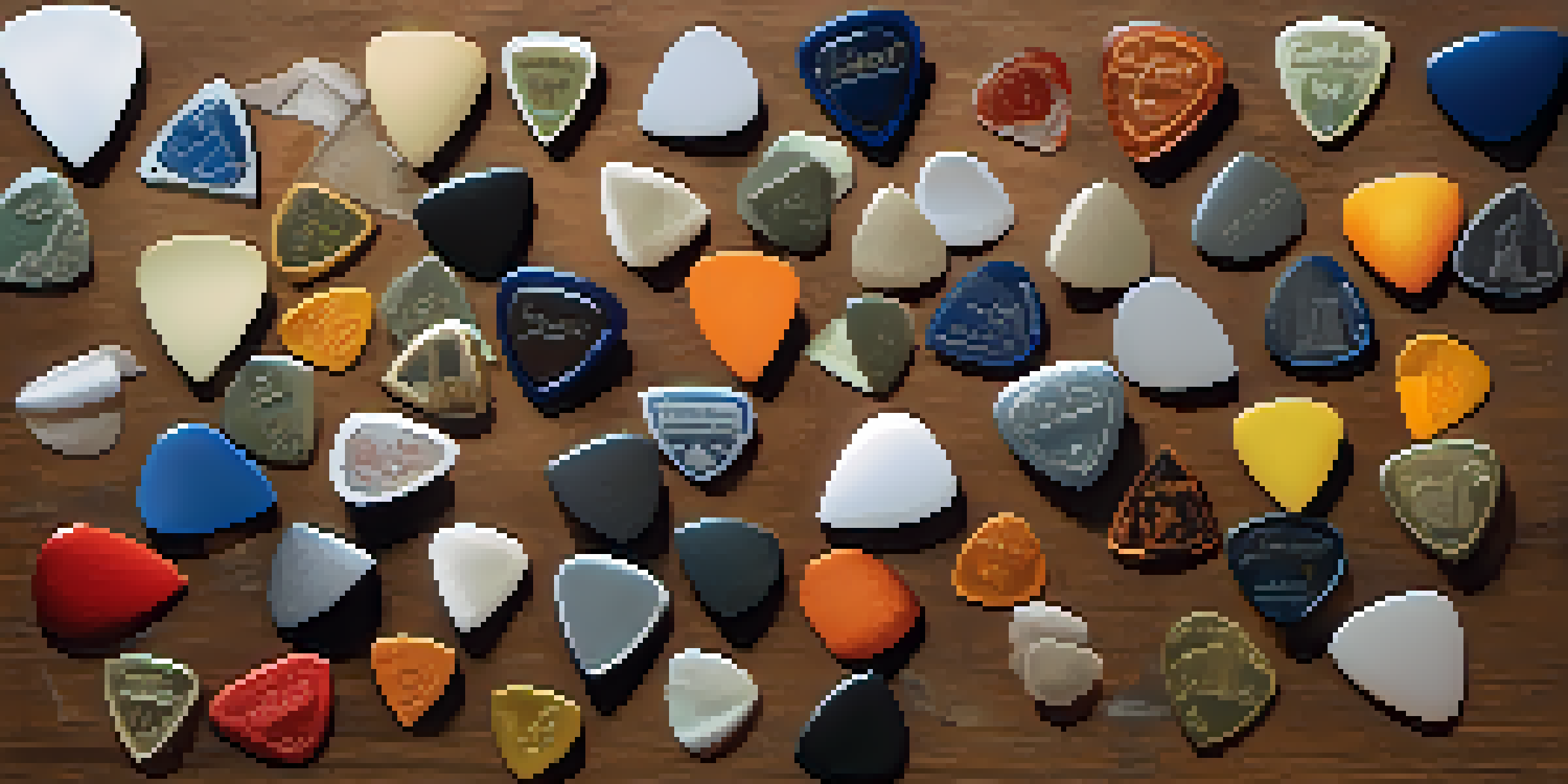The Impact of Guitar Picks on Tone: A Comprehensive Guide

Understanding Guitar Picks: Types and Materials
Guitar picks, or plectrums, come in various shapes, sizes, and materials, each affecting tone and playability. Common materials include plastic, nylon, and metal, with each offering distinct characteristics. For instance, a thicker pick may produce a brighter sound, while a softer pick can create a warmer tone. Knowing the types can help you choose the right one for your style.
The guitar is a small orchestra. It is polyphonic. Every string is a different color, a different voice.
Different shapes, like standard, jazz, and thumb picks, also cater to various playing techniques and genres. A standard pick is versatile for strumming chords, while a jazz pick's pointed tip excels in precision for solos. By experimenting with these shapes, you can discover which suits your unique playing style best.
Ultimately, the pick you choose is an extension of your musical expression. It not only shapes your sound but also affects your comfort and technique. So, understanding the basics of picks is crucial for any guitarist looking to enhance their performance.
How Thickness Affects Tone and Playing Style
The thickness of a guitar pick plays a pivotal role in determining your sound. Generally, thinner picks (0.38mm to 0.60mm) are more flexible and produce a lighter, brighter tone, making them ideal for strumming. Conversely, thicker picks (1.0mm and above) offer more control and a fuller sound, often preferred for lead playing.

When you strum with a thin pick, the flexibility allows for quick, fluid movements, which can enhance rhythm playing. However, this may come at the cost of precision, especially in fast-paced solos. On the other hand, a thick pick can give you the strength needed for aggressive picking, but it may require more effort for subtle strumming patterns.
Guitar Pick Types Matter
Different shapes, sizes, and materials of guitar picks significantly affect tone and playability.
Choosing the right thickness is about finding a balance that complements your style. It’s worth testing different thicknesses to see how they feel and sound in your hands. A simple shift from a thin to a thick pick can dramatically change your tonal landscape.
The Role of Material in Shaping Sound
The material of a guitar pick significantly influences the tone it produces. For example, nylon picks tend to offer a warm, rounded sound, while celluloid picks deliver a bright, clear tone. Each material has its unique properties that can enhance or alter your guitar's natural sound.
The beauty of the guitar is that it is not just an instrument, but a means of expression and creativity.
Moreover, the texture of a pick can affect grip and playability. For instance, a rougher surface might provide better traction, allowing for more aggressive strumming without slipping. In contrast, a smoother pick may glide effortlessly across the strings, ideal for intricate solos.
Understanding how different materials affect tone can guide your choice based on the music you want to create. Don’t hesitate to experiment with a variety of materials to find the one that resonates with your style and enhances your sound.
Pick Shape: Finding Your Perfect Fit
The shape of your guitar pick can also impact your playing technique and sound. Standard picks are great for general use, but if you play jazz or intricate solos, a jazz pick with a pointed tip can provide increased precision. Each shape caters to specific techniques, so it's essential to choose one that complements your style.
For example, thumb picks can be a game-changer for fingerstyle guitarists, allowing for a different attack on the strings. Meanwhile, larger picks might be better suited for players who prefer a heavier grip and more stability. The right shape can help you play with more confidence and comfort.
Thickness Influences Sound
The thickness of a guitar pick determines the sound produced, with thinner picks offering brightness and thicker picks providing control.
As with thickness and material, exploring various shapes will help you discover what feels best in your hand. The right pick shape can transform your playing experience, so don’t shy away from trying something new.
The Influence of Grip on Performance
Grip is a crucial yet often overlooked aspect of using a guitar pick. A pick that feels comfortable and secure in your hand can enhance your performance and reduce fatigue. Various manufacturers offer picks with unique textures or rubberized grips, designed to help you maintain control while playing.
A secure grip can lead to more precise strumming and picking, which is especially important in genres like rock or metal where speed and accuracy are key. Conversely, a slippery pick can lead to unintentional drops or misplays, disrupting your flow and confidence.
Experimenting with different grip styles can significantly improve your playing experience. Whether it’s a textured surface or a particular shape that fits your fingers, finding the right grip is essential for achieving the best sound.
Experimenting with Picks: Finding Your Sound
Finding the right guitar pick is a journey of experimentation and discovery. Guitarists often find that their sound evolves over time, influenced by various picks they try. Don't be afraid to explore different options, as picking the right one can lead to unexpected improvements in your tone.
Try mixing and matching picks for different styles or songs. You might find that a certain pick works beautifully for strumming, while another shines during solo performances. Keeping a selection of picks handy can help you adapt to different musical demands.
Grip Enhances Performance
A comfortable and secure grip on a guitar pick can lead to improved accuracy and reduced fatigue while playing.
Remember, the best pick is the one that feels right in your hands and complements your style. Take the time to experiment, as this exploration can lead to significant growth in your playing and sound.
Maintaining Your Picks: A Simple Guide
Maintaining your guitar picks can prolong their life and ensure consistent performance. Regularly inspect your picks for wear and tear, as worn picks can negatively affect tone and playability. A simple solution is to store them in a protective case to avoid scratches and damage.
Cleaning your picks can also enhance grip and sound. Wipe them down with a soft cloth after use to remove oils and dirt that may accumulate. For nylon or rubber picks, occasionally washing them with mild soap and water can keep them in great shape.

By taking care of your picks, you ensure they deliver the best possible sound every time you play. A little maintenance goes a long way in preserving the quality of your gear.